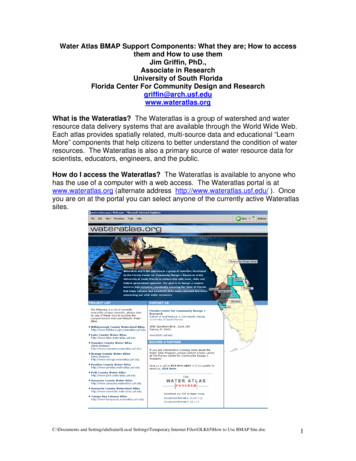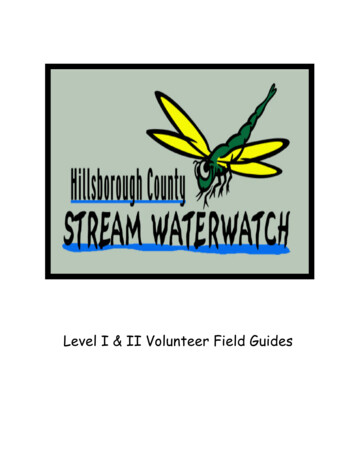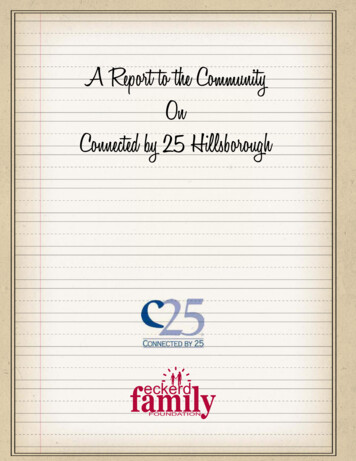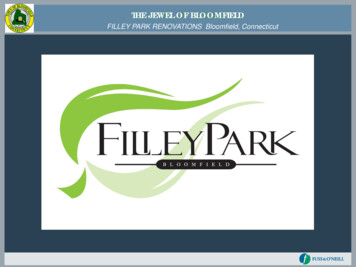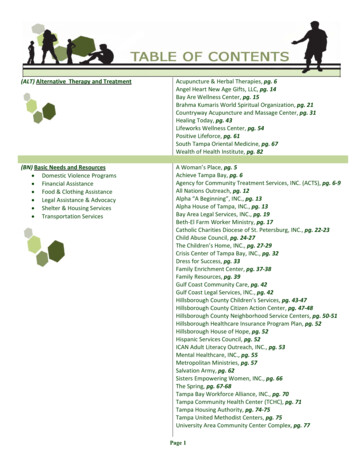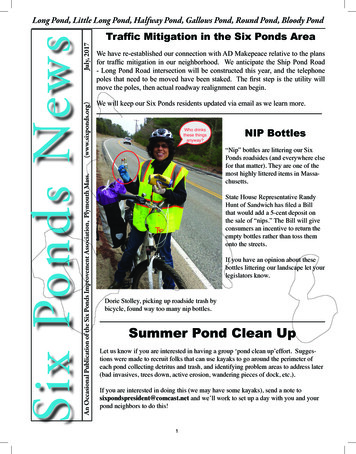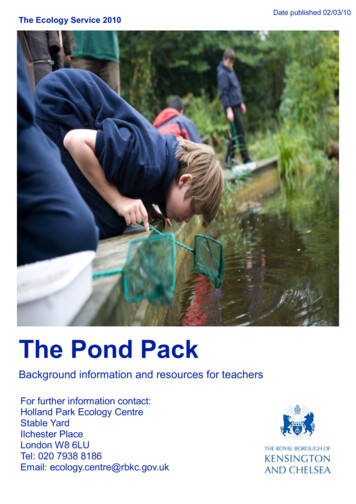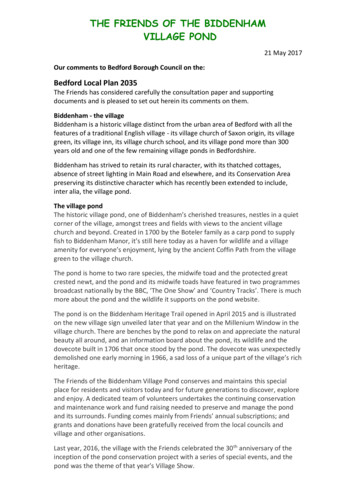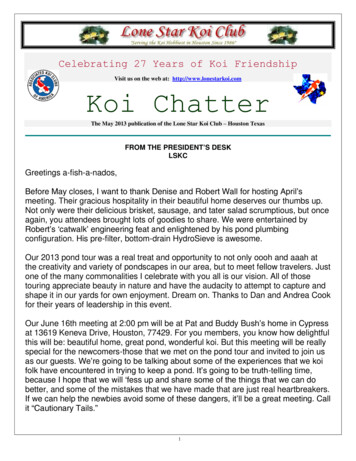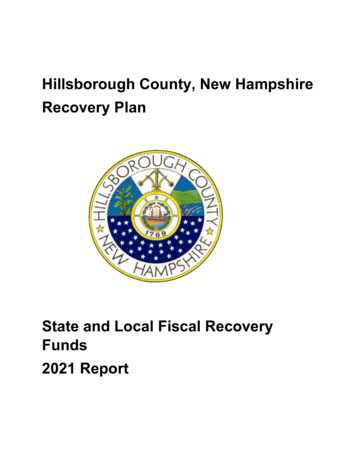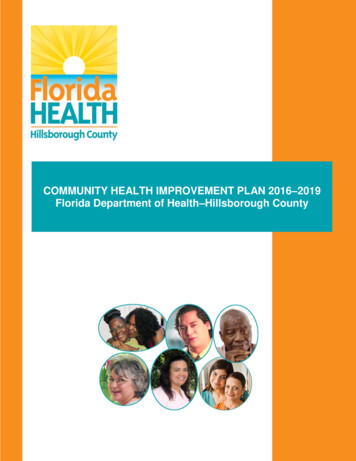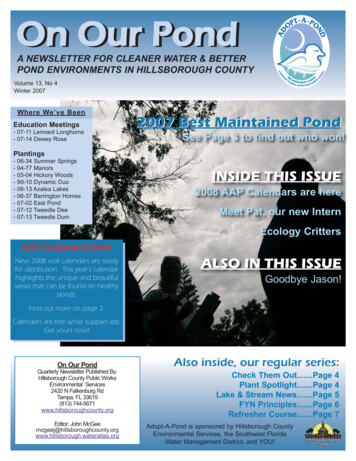
Transcription
On Our PondA NEWSLETTER FOR CLEANER WATER & BETTERPOND ENVIRONMENTS IN HILLSBOROUGH COUNTYVolume 13, No 4Winter 2007Where We’ve BeenEducation Meetings- 07-11 Lennard Longhorns- 07-14 Dewey Rose2007 Best Maintained PondSee Page 3 to find out who won!Plantings-06-34 Summer Springs94-77 Manors05-04 Hickory Woods99-10 Dynamic Duo06-13 Azalea Lakes06-37 Barrington Homes07-02 East Pond07-12 Tweedle Dee07-13 Tweedle DumINSIDE THIS ISSUE2008 AAP Calendars are hereMeet Pat, our new InternEcology CrittersAAP Calendar is Here!New 2008 wall calendars are readyfor distribution. This year’s calendarhighlights the unique and beautifulviews that can be found on healthyponds.ALSO IN THIS ISSUEGoodbye Jason!Find out more on page 2.Calendars are free while supplies last.Get yours now!On Our PondQuarterly Newsletter Published By:Hillsborough County Public WorksEnvironmental Services2420 N Falkenburg RdTampa, FL 33619(813) 744-5671www.hillsboroughcounty.orgEditor: John .wateratlas.orgAlso inside, our regular series:Check Them Out.PagePlant Spotlight.PageLake & Stream News.PageFYN Principles.PageRefresher Course.PageAdopt-A-Pond is sponsored by Hillsborough CountyEnvironmental Services, the Southwest FloridaWater Management District, and YOU!44567
On Our Pondpage 22008 CalendarsI said they’d be out on time if I could help it, and folks, I’m happy to say my word is good! 2008 Calendarsare ready for distribution. This edition features images highlighting the beauty and uniqueness of life aroundhealthy ponds. We’ve also improved the design of the calendar to make it more useful.And best of all, the images were taken by you!In the fall, we sent out announcements that we were seeking submissions for thecalendar. The response was good. Our team sorted through the photos and chosethe best ones, then debated the finalists until we came to an agreement. If yourphoto was chosen, you were notified, but unfortunately we couldn’t notifyeveryone who submitted. So let me say now, thank you to everyone whocontributed. We appreciate your efforts andenjoyed looking at all of your submissions.Contact us at mcgeej@hillsboroughcounty.orgor 744-5671 to request a calendar! They’re freewhile supplies last!Calendars feature pictures of life onadopted ponds.Meet Pat, our new internWe have a new intern from USF this semester. Pat Williams startedwith us in September, and is completing her final semester forDecember graduation with a bachelor degree in Environmental Policy.She is changing her career from an accounting background and is dedicated to doing her part in helping to protect and manage our preciouswater and ecological habitats. Pat has already assisted in two pondcleanings, several lake and storm drain inspections, and has helpedpresent educational sessions at two schools, Dowdell and Lennard.She made friends with Officer Snook and has enjoyed meeting themany people working in Public Works and Environmental Services.Pat hopes to utilize her knowledge from USF and experience with theCounty for continued care of Florida’s water systems, coastlines, andsoils and eventually wants to become involved in promoting effectiveand efficient policy toward that objective. Her favorite experience (sofar) was an inspection of a lake on the air boat! She is especiallyimpressed with the efforts of so many neighborhood volunteers in restoring the health and beauty totheir ponds and lakes. Pat will be looking forward to meeting you, too, some day soon!
On Our Pondpage 305-10 Does it Again!Yes, Black Pine Pond has accomplished a first in ourprogram history: they have won Best Maintained Pond twoyears in a row! How did they do it?Black Pine’s total score compiled from the individualjudges’ rankings was 200 out of 252. That’s one pointhigher than last year’s score of 199. Our judges wereimpressed by the fact that nearly every house on the pondhas planted their shoreline to some degree. And a coupleof yards feature door-to-shore landscaping using Floridafriendly principles. Residents have also addedimprovements such as docks and even turned a probleminto a decorative feature! A pipe entering the pond hadbegun to wash out, so the creative residents built adecorative wall to stabilize the pipe and prevent furthererosion.Black Pine is Best Maintained Pondtwo years running!Obviously everyone in this group cares about the pond and enjoys it. And Iknow the Group Representative, Gordon DeMouth, certainly does. He keepsin touch regularly, updating us on how things are going.Of course no pond is without its challenges. Any time people come togetherthere will be differences of opinion and things that just happen, but bystaying active and open to the community, Black Pine is able to address themand keep up a beautiful jewel of a pond! Congratulations Black Pine!2007 Pond JudgingBlack Pine was our winner, but we also want to recognize allthe other great ponds that competed. We had 12 pondscompete. That’s more than usual! Each one has it’s ownunique story and character, which makes judging a challenge.Our team of judges had a blast taking in all the work that wasdone. From the tranquil setting of Hickory Woods and ValleyRanch, to the manicured designs of Keystone Manors andAzalea Lakes, the immense scope of Lake Forest and the “edge of thewilds” feel of Reynoldswood and Marsh Crossings, even the fledglingsWhite Trout, Lakestone, Brigadoon, and Fallowfield made for a greatday. All of our ponds scored above the 50% mark and all 12 rankedwithin a 70 point range. Thanks to all of you who competed. We lookforward to seeing all of your ponds again next year. And if you didn’tcompete this year, make sure you get in next fall. You’ve got a year tomake it great!
On Our Pondpage 4Check them out: 99-10 Andre DrThe pond group at Andre Drive calls themselves the Dynamic Duo and for goodreason. This small pond bordered by two houses has been under the care of theSarwatka family for years. They are tireless in their efforts to keep the pond inshape.and they do it all by hand! For a long time, their son Owen was too youngto help, but as he’s gotten older, he’s well on his way to becoming another pondsuperhero.Look at all the debris!Does it really take that much work? Let me tell you, this pond is about as muchtrouble as they come. It’s shallow and goes dry regularly, it’s covered by treesthat drop ample leaves to clog and fill, and if thatweren’t enough, a tornado in 2005 smacked themgood, dropping in excess of 3 tons of debris.But that hasn’t stopped this group! They recentlyenlisted Owen’s Boy Scout troop and a volunteercorp from the University of Tampa to haul debris ontwo separate occasions. In addition, they’ve converted one side of their pond to an organic foodgarden, as part of the “Plant A Row, Grow aRow” Campaign to combat hunger. They expectto harvest around 200 pounds of potatoes thiswinter!While they are the first to tell you the pond needswork, I’m here to say, it isn’t for lack of effort ontheir part! Keep up the great work DynamicDuo!TrioThis 2002 Best Maintained Pond facedsetbacks, but they cleaned it all by hand.Pond Plant Spotlight–Dune SunflowerWhen planting your pond orlake edge, consider DuneSunflower (Helianthusdebilis) which comes fromthe traditional Sunflowerfamily but only reachesheights around 2 feet. ThisFlorida native plant is a greatground cover with a uniqueleaf appearance and plentifulflowers, which are attractiveboth to people and wildlife.Dune Sunflower is an annualplant but is often referred toas a perennial becausealthough parent plants dieafter about a year, they drop their own seedsto produce new plants in the next season (amonth or so later). Without a freeze,their growing season may be as long as15 months. Flowers areusually yellow and daisy-like,about 3 inches wide, with apurplish-brown center andmake great dried flowers!Dune Sunflower isversatile and hardy.Dune Sunflowers are droughtresistant, happiest in fullsandy sun, yet comfortable inpartial shade and a widerange of soils. What theydon’t like is over-watering orover-fertilizing, so theseplants make a perfect bufferon pond slopes, as well as anexcellent Florida-friendlylandscape plant. You’ll be rewarded withcolorful blooms year-round, happybutterflies and birds, and a system ofself-rejuvenating plants for a dynamiclandscape.
On Our Pondpage 5sweNmaertS&ekLaGoodbye from Jason MickelGoals for Winter 2007 Continue to recruit andtrain volunteers in theLAKEWATCH andStream WaterwatchprogramsUpdate the design of theWatershed Atlas and addgreat new research,documents, and featuresContinue to providetechnical assistance,education, andmanagement strategiesto Hillsborough CountycitizensI wanted to take this opportunity to let everyone know that I accepted a positionwith the Southwest Florida Water Management District in the beautiful outskirtsof Brooksville. It was a long, difficult decision, but I could not pass up theopportunity. My three years working for the County have been tremendous,with great opportunities to manage important County programs that made a realdifference in the community. Throughout my tenure with the County, I havebeen fortunate to work with such a dedicated group of professionals and citizenvolunteers with the common goal of improving our community and environment. I look forward to working with everyone in another capacity in thefuture.My last day at the County was Friday, November 2, 2007, but the Lake &Stream Management Program will continue to help citizens make informedmanagement decisions, collect vital water quality data, and reach out to thecommunity. The program will also continue to partner and coordinate with theSouthwest Florida Water Management District, the University of South Florida– FCCDR, the University of Florida – Lakewatch, and HillsboroughCommunity College – Stream Waterwatch.If you have any questions or concerns regarding these programs, please contactDavid Glicksberg at 744-5671.Talk to you later,Jason MickelEditor’s Note: Lake & Stream InfoLast issue, we announced that Lake & Stream News wouldbecome a part of the “On Our Pond” newsletter. We hadplans to merge this newsletter into one publication thatwould cover all of our programs, with an increasingpresence of lake and stream information. However, due tothe recent resignation of our Lakes Manager, these plansmust be put on hold for the time being. We will continue tooffer basic information regarding the lake and streamprograms through this time of transition and will hopefullybe able to bring you more regarding lakes and streams whenthe position is filled. With any luck, that won’t be a longdelay. We’ll keep you posted!Best of luck, Jason!See you around!www.hillsborough.wateratlas.org
On Our Pondpage 6Florida Yards & Neighborhoods Principle: Fertilize AppropriatelyBy Lisa Strange, FYN Community Association CoordinatorThis is the third in a series on the nine principles of theFlorida-friendly landscaping concept, which is designed toproduce attractive, low-maintenance, environmentally-friendlylandscapes that also provide habitat for wildlife and reduce thespread of invasive plants.Once established, trees and plants require little or no fertilizer.In fact, fertilizers can be hazardous to the health of your yardas well as the environment when overused or appliedincorrectly. Too much fertilizer aggravates insect and diseaseproblems and causes excessive growth. Excess fertilizers canalso run off yards into storm drains and waterways or leachinto the aquifer, polluting our drinking water. The safestfertilizer is “slow-release” fertilizer. This term “slow release”will be on the bag with the amount of nitrogen that is slowrelease. Slow release fertilizers have less potential to leach in toour water sources.Nitrogen from fertilizer is themajor pollutant of Tampa Bay.Guidelines: Fertilize only as needed to maintain the health of lawns and landscapeplants. Use fertilizers that contain at least 30% slow-release nitrogen. Use iron (ferrous sulfate or chelated iron) instead of nitrogen to makeyour lawn green in the summer.FERTILIZATION GUIDELINES FOR ESTABLISHED TURFGRASS LAWNS IN THREE REGIONS OF FLORIDAFACTORS THAT DETERMINEPOLLUTION POTENTIAL FROMLAWN FERTILIZING Type of fertilizer How much you apply How you apply it When you apply How much irrigation you applyafterwards Overall health of the lawnlbs N / 1000 ft2 / -54-65-7Centipede1-22-32-3St Augustine2-42-52-6Zoysia3-53-64-6North Florida is north of Ocala. Central Florida is defined as south of Ocala to a lineextending from Vero Beach to Tampa. South Florida includes the remaining southernportion of the state.When fertilizing woody landscape plants and palms,refer to “The Guide to Florida-friendlyLandscaping”, pages 55-56.To learn more about Florida-friendly principles,visit www.FloridaYards.org. Also checkhillsborough fyn.ifas.ufl.edu or call the Extensionoffice at 744-5519 for info on what’s going onlocally.Nitrogen recommendations recommended by the UF Turf grass Science Program.The FYN Community Association Outreach program in Hillsborough and Polk counties isfunded by the Southwest Florida Water Management District and the Boards of CountyCommissioners of Hillsborough and Polk counties.
On Our Pondpage 7Refresher Course: Aging Water BodiesWe’re continuing our series on basic pond information.Did you know that ponds can be born, age, and die?It works in every ecosystem in different ways.Periodically things like fire, floods, and erosion willreset the succession process.It’s true. All water bodies have a life cycle. Sometimes,this life cycle is so long itPonds grow old and change to fields.seems to us like they’re alwaysthere and always will be. Butin smaller bodies like ponds, wecan actually see the agingprocess.In Florida, ponds are usuallyborn when a sinkhole opens, orwhen we dig one. Because thewater table in Florida is so high,even very shallow holes can fillwith water. That’s the birth of apond!Almost instantly, life startsmaking use of the new habitat,and before you know it, therewill be plants growing in thewater. This draws creatures thatlive on or eat the plants, andthose, in turn, draw animals thateat them. In a few short years, the hole will become athriving pond full of vegetation, insects, frogs, reptiles,birds, and even fish! No one is quite sure how fish getthere but they do, probably transported by birds, orswimming in when connections to other water bodies areavailable.But that’s not the end of the story. All those livingthings produce waste and eventually die. Over time thatdead stuff, from plants and animals, starts building up onthe bottom of the pond. This makes the pond shallower.Plants quickly start living in the areas where theycouldn’t before. In a natural setting this happens soslowly that we wouldn’t notice, unless we watch thesame pond for years and years. We’d see less and lessopen water and more marshy area. Eventually the pondwould be covered by vegetation all the way across.At this point, we call it a bog or marsh rather than apond. But, the cycle still isn’t over. The marsh willcontinue to fill in until it becomes a field or meadow anddry land species come in. Then somewhere else, a pondwould open up and the process would start in that place.What I’ve just described is a process called succession.So now for some application.You might have realized howyour pond fits into thisprocess. Understanding whatstage of its life cycle the pondis in will help you know whatto expect next and how tomanage it. But here’s thecatch, we’ve built permanentroads and buildings where newponds would have beenforming. We don’t have thespace to let our ponds movearound. To make mattersworse, our man-madeenvironments cause ponds toage much much faster. Whileit might take a natural pond100 years or more to turn to amarsh, our man-made pondscan do it in 10 years or less.This means we will have tokeep artificially resetting the succession in our ponds,as long as we need the pond to stay where it is, andthat costs time and money.That’s why it’s important for us to slow the agingprocess down as much as we can. We do that byhelping the pond work as close to the way it would ina natural setting. And you’ve guessed it, that’s exactlywhat Adopt-A-Pond is designed to do!An old pond, slowly filling in.
The Adopt-A-Pond ProgramHillsborough County Public Works Dept.Environmental Services Group2420 N Falkenburg Rd.Tampa, FL 33619Bill to Mail Code 1384Pre sort StandardU.S. Postage PaidTampa, FL 33601Permit No 295Hillsborough County Board of County CommissionersAn Affirmative Action-Equal Opportunity EmployerOn Our Pondpage 8Visit These WebsitesAdopt-A-Pond ion Office:http://hillsborough.extension.ufl.eduFrog Listening Network:www.seaworld.org/fln/in.htmHillsborough County Watershed p://lakewatch.ifas.ufl.eduScience Daily:www.sciencedaily.comSouthwest Florida Water ManagementDistrict: www.watermatters.orgTampa Bay Estuary Program:www.tbep.orgEcology CrittersIn the past three issuesyou’ve seen Kenny, our erosion critter. Now he’d likesome friends, and we betyou know what they looklike. So we want to seeYOUR ecology critters!An ecology critter representsa force or process in theenvironment, like erosion,sedimentation, and eutrophication! So, draw a picture of it and tell us its name and job (whatforce or process it represents). We’ll print the best of them in thenext newsletter. Since we’ve already seen erosion, make sure youpick a different one.We can’t wait to see what critters you’ve spotted and we hope thenext issue is just crawling with them! There’s no age limit on thisone, so everyone can pull out those colored pencils, paints,crayons, and paper. You can mail your pictures to the address onthe front cover, or scan them and email to:mcgeej@hillsboroughcounty.org
Hillsborough County Public Works Environmental Services 2420 N Falkenburg Rd Tampa, FL 33619 (813) 744-5671 www.hillsboroughcounty.org Editor: John McGee mcgeej@hillsboroughcounty.org www.hillsborough.wateratlas.org Volume 13, No 4 Winter 2007 Adopt-A-Pond is sponsored by Hillsborough County Environmental Services, the Southwest Florida
